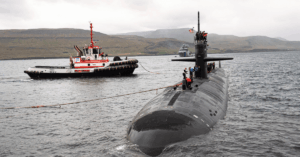
Greek Shipping Firms On High Alert After Series Of Mysterious Blasts Near Russia
July 10, 2025
Armed Robberies Surge In Singapore Strait, Hit Highest Level Since 2020
July 10, 2025

The U.S. Navy’s nuclear-powered fast-attack submarine USS Newport News (SSN 750) made history by docking at Grundartangi, Iceland on July 9, 2025. This is the first time a U.S. nuclear-powered submarine has entered port on Icelandic shores.
This happened just two years after Iceland first allowed these submarines into its waters, beginning with a brief supply visit by the USS San Juan in 2023. Now, the arrival of the Los Angeles-class USS Newport News has become a symbol of deepening security ties in the region.
According to the U.S. Navy, the submarine’s presence shows Washington’s commitment to Arctic stability, freedom of navigation, and NATO’s collective defense.
U.S. Naval Forces Europe-Africa emphasised that its submarine fleet plays a crucial role in patrolling contested waters and acting as a deterrent in a complex security environment.
The USS Newport News is one of the Navy’s most capable submarines, equipped with advanced surveillance systems, Tomahawk cruise missiles, and MK-48 torpedoes. It can carry out missions ranging from anti-submarine and anti-ship warfare to intelligence gathering and special operations.
Unlike older diesel-electric submarines, nuclear-powered vessels like Newport News can stay submerged for months, giving them superior reach and stealth.

The submarine has a strong record in Arctic missions, having earned three Arctic Service Ribbons for operating above the Arctic Circle over its 36-year service life.
The Navy said the visit showcases the professionalism and readiness of its crew and demonstrates the United States’ ability to project power in even the harshest environments.
Strategically, Iceland plays a critical role as it is located in the Greenland-Iceland-United Kingdom (GIUK) gap, a key passage for Russian submarines traveling from Murmansk into the North Atlantic. U.S. officials have long considered this area vital for tracking Russian undersea movements before they can threaten Atlantic security.
During the Cold War, Iceland hosted U.S. Air Force fighters and maritime patrol aircraft at Keflavik Air Base. Today, that legacy continues through NATO fighter rotations and P-8A Poseidon surveillance flights.
The recent increase in Russian submarine activity and military buildup near Finland has only added urgency to strengthening defenses in the High North.
NATO has also stepped up surveillance in the region. A recent RQ-4D Phoenix drone mission from Finland focused on the GIUK gap.
Reference: US Navy
Source: Maritime Shipping News


